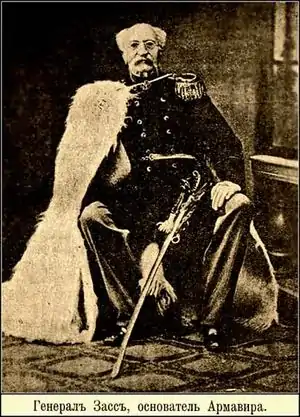Grigory Zass
Grigory Khristofovich von Zass (Russian: Григорий Христофорович фон Засс; German: Georg Otto Ewald Freiherr von Saß) was a Russian Imperial general of German origin in the 19th century who commanded Russian troops in the Russo-Circassian War.[1][2][3][4][5][6] He initially gained fame for his racist views and cruel methods against the indigenous Circassians, wIho he described as "subhuman filth", and justified their killing and use in scientific experiments.[7][8][9][10][4][11][5][6]
 | |
| Native name | Григорий Христофорович фон Засс |
|---|---|
| Nickname(s) | The Devil |
| Born | April 29, 1797 Westphalia |
| Died | December 4, 1883 Russia |
| Allegiance | |
| Years of service | 1813-1849 |
| Battles/wars | Russo-Circassian War Russo-Turkish War (1828–29) |
| Awards | Order of St. George Order of Saint Vladimir Order of Saint Anna Order of Saint Stanislaus Cross of St. George |
Biography
Originally from Westphalia, he gained success among Russian ranks especially in the Leipzig war. In 1820 he was transferred to the Novgorod division. He participated in the Russo-Turkish War (1828–29). During the height of the Russo-Circassian War, in 1833, he was appointed as the chief commander.[3]
Colonel Zass received wide authority. He had racist views[11][10][8][7][4][6] and regarded the Circassians as a lower race than the Russians and other Europeans. In his view, the only way to deal with the Circassians was to scare them. From that concept, Zass developed new military methods – burning people alive, and cutting off the heads of corpses.[3][12]
Colonel Grigory Zass played a major role in the Circassian genocide[7][1][8][9][10][11][5][6] via ethnic cleansing with many methods such as burning Circassian villages whole, deliberately causing epidemics, entering villages and towns with the white flag and then killing everyone. It is estimated 70% of the East Circassian population died in the process.[7][1] In addition, it was recorded that Zass dismembered Circassian corpses, hid them as ornaments and sent them abroad to be used as test subjects.[7][4][11][5][6]
Sources
- Щербина Ф. А. История Армавира и черкесо-горцев. — Екатеринодар: Электро-тип. т-во «Печатник», 1916.
- ki, Muzaffer yıldırım dedi (2018-05-31). "General Zass'ın Kızının Adigeler Tarafından Kaçırılışı". ÇERKES-FED (in Turkish). Retrieved 2021-01-13.
- "Jembulat Bolotoko: The Prince of Princes (Part One)". Jamestown. Retrieved 2021-01-05.
- "Bianet :: Çerkeslerden Rusya'ya: Kolonyalist politikalarınız nefret ekiyor". m.bianet.org. Retrieved 2021-01-13.
- Узел, Кавказский. "Засс Григорий Христофорович". Кавказский Узел. Retrieved 2021-01-13.
- "ЗАСС Григорий Христофорович фон (1797–1883), барон, генерал от кавалерии, герой Кавказской войны". enc.rusdeutsch.ru. Retrieved 2021-01-13.
- Richmond, Walter (2013-09-02). "Velyaminov, Zass ve insan kafası biriktirme hobisi". Jıneps Gazetesi (in Turkish). Retrieved 2020-09-26.
- Duvar, Gazete (2020-09-14). "Kafkasya'nın istenmeyen Rus anıtları: Kolonyal geçmişi hatırlatıyorlar". Gazeteduvar (in Turkish). Retrieved 2021-01-13.
- "'Benim Adım 1864'". Sivil Sayfalar (in Turkish). 2020-05-21. Retrieved 2021-01-13.
- Rajović, G. & Ezhevski, D.O. & Vazerova, A.G. & Trailovic, M.. (2018). The Tactics and Strategy of General G.Kh. Zass in the Caucasus. Bylye Gody. 50. 1492-1498. 10.13187/bg.2018.4.1492.
- "Son Haber | 21 Mayıs 1864 Çerkes Soykırımı". Son Haber (in Turkish). 2020-05-20. Retrieved 2021-01-13.
- Ibid., p. 420.
